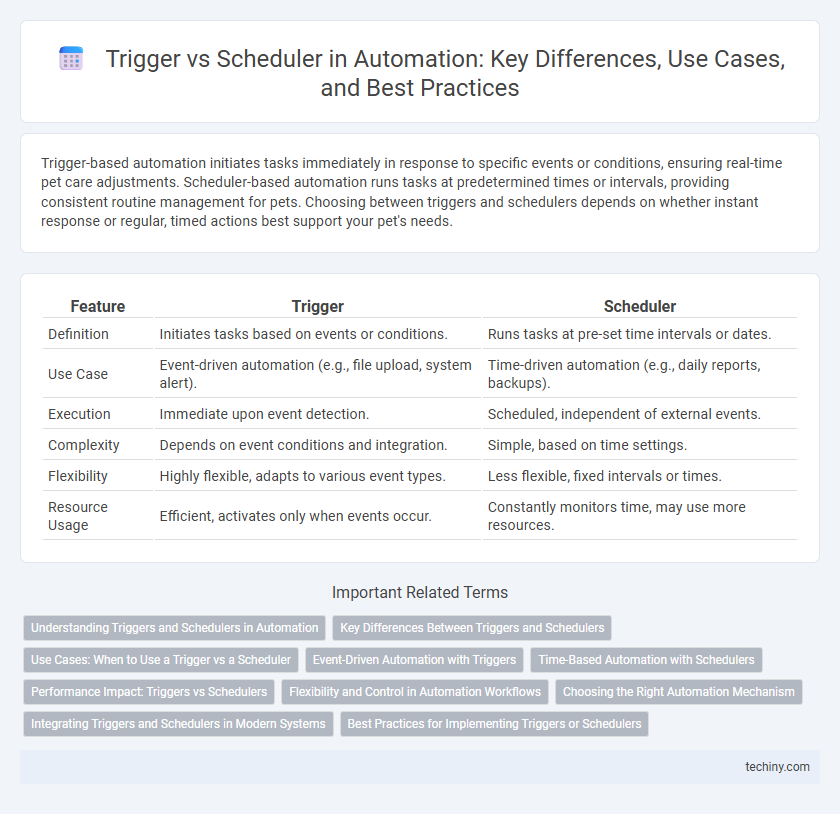Trigger-based automation initiates tasks immediately in response to specific events or conditions, ensuring real-time pet care adjustments. Scheduler-based automation runs tasks at predetermined times or intervals, providing consistent routine management for pets. Choosing between triggers and schedulers depends on whether instant response or regular, timed actions best support your pet's needs.
Table of Comparison
| Feature | Trigger | Scheduler |
|---|---|---|
| Definition | Initiates tasks based on events or conditions. | Runs tasks at pre-set time intervals or dates. |
| Use Case | Event-driven automation (e.g., file upload, system alert). | Time-driven automation (e.g., daily reports, backups). |
| Execution | Immediate upon event detection. | Scheduled, independent of external events. |
| Complexity | Depends on event conditions and integration. | Simple, based on time settings. |
| Flexibility | Highly flexible, adapts to various event types. | Less flexible, fixed intervals or times. |
| Resource Usage | Efficient, activates only when events occur. | Constantly monitors time, may use more resources. |
Understanding Triggers and Schedulers in Automation
Triggers in automation initiate workflows based on specific events or conditions, enabling real-time responses to changes such as file uploads or system alerts. Schedulers activate tasks at predetermined times or intervals, ensuring regular execution without manual intervention, such as nightly data backups or report generation. Understanding the distinct roles of triggers and schedulers enhances workflow efficiency by aligning automation strategies with event-driven or time-driven requirements.
Key Differences Between Triggers and Schedulers
Triggers initiate automation workflows based on specific events or conditions, enabling real-time responses to changes within systems or applications. Schedulers execute automated tasks at predefined times or intervals, ensuring consistent and periodic operation without dependency on external events. The key difference lies in triggers being event-driven while schedulers are time-driven, impacting their use cases in automation strategies.
Use Cases: When to Use a Trigger vs a Scheduler
Triggers are ideal for real-time automation when immediate action is required based on specific events or conditions, such as processing a new order as soon as it is placed. Schedulers excel in handling repetitive tasks or batch processes that need to run at fixed intervals or predefined times, like generating daily reports every midnight. Use triggers for event-driven workflows demanding instant responses, and employ schedulers for time-driven tasks that benefit from consistent execution schedules.
Event-Driven Automation with Triggers
Triggers in event-driven automation initiate processes immediately upon detecting specific events, enabling real-time responsiveness and reducing delays. Unlike schedulers that run tasks at predetermined times, triggers respond dynamically to changes such as data updates, user actions, or system alerts. This approach optimizes workflow efficiency by executing automation precisely when necessary, increasing operational agility and minimizing resource waste.
Time-Based Automation with Schedulers
Schedulers automate tasks by triggering actions at predetermined times or intervals, optimizing workflows through precise time-based execution. Unlike event-driven triggers that respond to specific conditions, schedulers rely on calendars and clocks to initiate processes, ensuring consistent timing and reliability. Time-based automation via schedulers enhances operational efficiency by reducing manual intervention and enabling predictable task management.
Performance Impact: Triggers vs Schedulers
Triggers execute instantly in response to specific events, providing real-time automation with minimal latency but can consume more system resources under heavy transactional loads. Schedulers run predefined tasks at set intervals, optimizing CPU usage by spreading workload over time but may introduce delays in task execution. Choosing between triggers and schedulers depends on balancing the need for immediate response against overall system performance and resource availability.
Flexibility and Control in Automation Workflows
Triggers provide real-time flexibility by initiating automation workflows instantly based on specific events or conditions, enabling responsive and dynamic control. Schedulers offer precise control over timing, allowing workflows to run at predefined intervals or specific times without manual intervention. Combining triggers and schedulers in automation enhances workflow adaptability and operational efficiency by balancing immediate response with predictable execution.
Choosing the Right Automation Mechanism
Choosing the right automation mechanism depends on the specific use case and timing requirements; triggers initiate actions instantly based on specific events such as data changes or user inputs, ensuring real-time responsiveness. Conversely, schedulers execute tasks at predefined intervals or times, optimizing resource utilization for repetitive processes like batch data processing or report generation. Balancing the immediacy of triggers with the predictability of schedulers enhances overall system efficiency and scalability.
Integrating Triggers and Schedulers in Modern Systems
Integrating triggers and schedulers in modern automation systems enhances operational efficiency by combining event-driven actions with time-based workflows. Triggers respond instantly to specific events, enabling real-time processing, while schedulers execute tasks at predetermined intervals to maintain routine operations. Seamless integration leverages both mechanisms to optimize resource utilization and ensure adaptive system responsiveness.
Best Practices for Implementing Triggers or Schedulers
Implementing triggers or schedulers requires aligning with system requirements and workload patterns to optimize automation efficiency. Best practices include setting precise conditions for triggers to minimize false activations, while schedulers should be configured for optimal timing to reduce resource contention. Leveraging monitoring tools ensures timely adjustments, maintaining reliable and scalable automation workflows.
Trigger vs Scheduler Infographic

 techiny.com
techiny.com